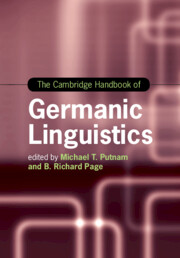Book contents
- The Cambridge Handbook of Germanic Linguistics
- Cambridge Handbooks in Language and Linguistics
- The Cambridge Handbook of Germanic Linguistics
- Copyright page
- Contents
- Figures
- Maps
- Tables
- Contributors
- Acknowledgments
- Germanic Languages
- Part I Phonology
- Chapter 1 Phonological Processes in Germanic Languages
- Chapter 2 Germanic Syllable Structure
- Chapter 3 The Role of Foot Structure in Germanic
- Chapter 4 Word Stress in Germanic
- Chapter 5 Quantity in Germanic Languages
- Chapter 6 Germanic Laryngeal Phonetics and Phonology
- Chapter 7 Tone Accent in North and West Germanic
- Chapter 8 Intonation in Germanic
- Part II Morphology and Agreement Systems
- Part III Syntax
- Part IV Semantics and Pragmatics
- Part V Language Contact and Nonstandard Varieties
- Index
- References
Chapter 5 - Quantity in Germanic Languages
from Part I - Phonology
Published online by Cambridge University Press: 31 March 2020
- The Cambridge Handbook of Germanic Linguistics
- Cambridge Handbooks in Language and Linguistics
- The Cambridge Handbook of Germanic Linguistics
- Copyright page
- Contents
- Figures
- Maps
- Tables
- Contributors
- Acknowledgments
- Germanic Languages
- Part I Phonology
- Chapter 1 Phonological Processes in Germanic Languages
- Chapter 2 Germanic Syllable Structure
- Chapter 3 The Role of Foot Structure in Germanic
- Chapter 4 Word Stress in Germanic
- Chapter 5 Quantity in Germanic Languages
- Chapter 6 Germanic Laryngeal Phonetics and Phonology
- Chapter 7 Tone Accent in North and West Germanic
- Chapter 8 Intonation in Germanic
- Part II Morphology and Agreement Systems
- Part III Syntax
- Part IV Semantics and Pragmatics
- Part V Language Contact and Nonstandard Varieties
- Index
- References
Summary
This chapter provides a typological overview of segmental quantity in Germanic languages. It begins with an overview of basic terminology, different ways of representing quantity, and the effects of different diachronic processes (e.g., open syllable lengthening and degemination) on the occurrence of contrastive segmental quantity. After a presentation of Riad’s (1995) typology of quantity, the chapter describes North and West Germanic language varieties that preserve both vowel and consonant quantity, varieties that retain only consonant quantity and varieties that retain only vowel quantity. Also included are discussions of complementary quantity, syllable cut and evidence that some Germanic varieties no longer have contrastive segmental quantity.
Keywords
- Type
- Chapter
- Information
- The Cambridge Handbook of Germanic Linguistics , pp. 97 - 118Publisher: Cambridge University PressPrint publication year: 2020



